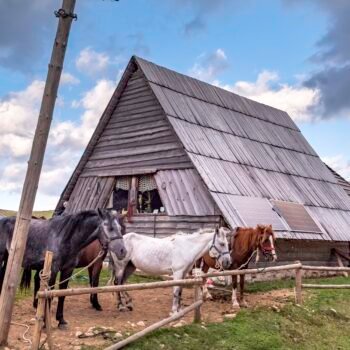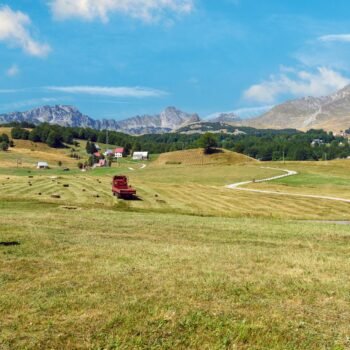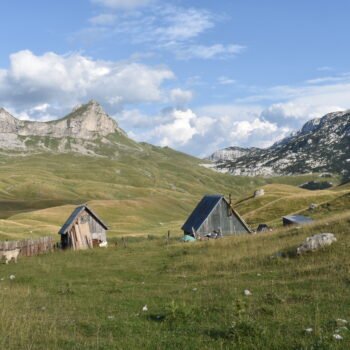- /
- Katun Road The Great...
- /
- Katuns
Katuns
EACH KATUN TELLS ITS OWN STORY
Of course, as seasonal summer dwellings for livestock breeders, katuns across Montenegrin mountains share many common features. However, you will soon discover that each katun along our route tells a unique story.
They are typically located above 1300 meters, most often around 1500 meters. The highest one is Todorov Do on Durmitor, sitting at 1816 meters above sea level.
Katuns have their own past, just like the families who come to them. They never appeared by accident—each spot for a hut was chosen with care. That’s why katuns on the mountains are places where you sometimes immediately sense their “geopoetics,” while at other times, you need to linger, observe, breathe deeply, maybe even spend the night, listen to the majestic silence, get closer to the stars, in order to feel what makes them unique.
Some katuns are far from villages. Some are far from forests. Some are far from water. Others rely on springs, forests, and nearby villages.
Just like centuries ago, the main figure at the katun is woman. She will gladly show you her many tasks: lighting the fire, milking, making cheese and cream, kneading bread, cooking, preparing juices and jams, tending the garden, picking medicinal herbs, weaving… Even the smallest help means a lot to her.
Never doubt the sincerity of the welcome you’ll receive from the hosts in the highlands—where the howling of wolves and cries of eagles echo, where bears and wild boars roam. Here, one human being is a joy to another.
Find your katun.
EVEN SNOW QUENCHES THIRST
Each Montenegrin mountain is unique, and so is life in each katun. While, for example, the Proscenje mountains always have ample water and forest, Sinjajevina and Piva often left livestock breeders struggling due to water scarcity.
But where there were no springs, there was snow.
Resourceful and diligent, herders built snow pits. During winter or early spring, they would pack snow into shady pits or caves and cover it with fir or spruce branches and straw. In summer, women would “cut” that snow and bring it to the house, place it on the roof to melt or into wooden troughs from which livestock drank. Some snow pits served multiple households.
THE WOLVES OF PROSCENJE
All katuns in Proscenje are situated on a plateau above the Tara ridge. They are not easily accessible—it’s quite steep—but there are footpaths for driving the livestock. They are one and a half to two hours’ walk from the nearest village. The pastures are vast, and there are meadows for mowing. There are also many springs, streams, and puddles. Forests are mostly coniferous. Wolves are frequent visitors here, so livestock must be carefully guarded.
TALES FROM SINJAJEVINA
Sinjajevina could graze thousands and thousands of sheep. But despite all that grass, there are no lakes, springs, or puddles. Mountain peaks lie on the periphery, so a tree or forest in this wide open space can appear like a mirage. That’s why snow pits were essential.
In some katuns on Sinjajevina, families stay until October. Herders from Gornje Lipovo, Moraca villages, Bjelopavlici, and even from the Skadar Lake area come here.
Perhaps the most famous katun area on Sinjajevina bears a beautiful name—Ruzica. In the katun of Okrugljak, every year on August 2nd, a large gathering is held at the church of Ruzica. The church is dedicated to Saint Basil of Ostrog, and was built by the people of Bjelopavlici as a token of gratitude. The inscription reads:
“This holy church of Saint Basil of Ostrog the Miracle Worker was built by the people of Bjelopavlici in 1894 in eternal gratitude to His Highness Prince Nikola I Petrovic Njegos, who in 1881 granted them summer pasture on this mountain.”
In 1881, Prince Nikola I Petrovic granted the people of Bjelopavlici grazing rights on Sinjajevina as a reward for special merits. They would travel with their herds for up to three days to reach the katuns. At one point, they had about 400 huts. Between 1930 and 1940, as many as 40,000 sheep and 3,000 cattle, along with 500 horses, would arrive just from Bjelopavlici. The ascent usually began on June 15, and the return was around St. Demetrius’ Day (Mitrovdan). Everything was organized in agreement, and each year a president of Bjelopavlici’s Sinjajevina was elected.
There were many savardaks on Sinjajevina—spacious round huts covered with rye straw.
KATUNS ON LUKAVICA
The Lukavica mountain has long been home to many katuns used by various clans and even entire tribes for summer grazing. This beautiful mountain is ideal for livestock raising—it offers vast pastures and abundant flowing water, while the forest lies just a bit farther from the katuns. The huts in these katuns are traditionally built with dry stone walls and roofs covered with wooden planks, shingles, or turf.
Among the many katuns on Lukavica is the so-called Ivan-beg’s katun. According to local legend, it was founded more than five hundred years ago by the ruler Ivan Crnojevic.
Below the peaks of Veliki and Mali Zurim lies the half-abandoned Zagaracki katun. The people of Zagarac, according to oral tradition, asked King Nikola for the right to graze there and now make a day-and-night journey with their livestock to reach Lukavica.
The Piperski katun still holds out hope for the return of a new herd.
Around Kapetanovo Lake, local women are known for making top-quality layered cheese.
THE MOST BEAUTIFUL IN THE REGION
On Brnik Mountain (part of the Moraca Mountains), there are several katuns—Nisin Kiljan, Kapetanovo Lake, and Brnjik among them. These are said to be the most beautiful katuns in the entire area. They attract numerous hikers, scouts, and explorers. Water is abundant, and the mown meadows are a signature feature of these katuns. Forest is nearby, and the huts are built close together. The seasonal migration to the mountains begins in early June, and the return typically happens at the end of September—though some stay even longer.
KATUNS OF DURMITOR
In this region, the huts were built with great care and quality, usually of coniferous wood atop low stone walls. Their roofs were tall to withstand the several meters of snow that could fall. The only opening was the door, made of thick wooden planks. A smaller nearby hut—called the mljekar—was used to make and store cheese and kajmak.
Enclosures for livestock were typically very tall and sharpened at the top to deter wolves, which could appear both day and night.
Herders usually migrated to the katuns around the end of May and returned to the villages at the end of September.
Some katuns are scattered, others grouped together. Those on Stuoc offer stunning views of the surrounding peaks. The katuns in Alisnica, at the base of Durmitor, are tucked away in lush grasslands where livestock thrive. The katuns in Dobri Do are so large that they merge with the area of Piva; they are home to the largest herds and offer abundant water, expansive pastures, and dense conifer forests.
Katuns in Poscenje are not far from the village—pastures often border private land. Water is plentiful—there are three lakes and several springs. Residents of Bukovica maintain katuns on the Ivica plateau, which can be reached in less than an hour. There, they have everything they need: vast pastures, water, and forest.
THE PIVA SHEEP
Conditions shape the breed, and even experts agree that the Piva sheep (pramenka) is larger than those from other regions. It is considered an indigenous species, well-adapted to cold climates. In general, sheep handle winter and changing weather better than cattle—which is why they are raised more widely. They can graze on grass growing between rocks, where cows can’t even reach.
Sheep are not just sources of milk—they provide wool for clothing, and their hides are used to make mjesine (leather sacks) for storing skorup (clotted cream).
While adults watched over cattle—or let them return to the katun on their own in the evening—sheep and lambs could be herded by children, sometimes as young as seven or eight years old.
It used to be said that a farmer who had everything but no sheep was still poor. The number of sheep was a measure of wealth. A typical flock had 50–80 animals, medium-sized flock 80–130 and those with 200–300 sheep were considered wealthy.
The biggest problem in the katuns of Piva—despite being surrounded by powerful canyons—was always water. That’s why snow storage pits (snijeznice) were built, or, in extreme cases, leftover snow was extracted from pits and caves. In dry years, when snow reserves, puddles, and shallow wells dried up, herders had to take their animals down the steep canyons of the Piva and Tara rivers—an exhausting journey for both humans and livestock.
UNFORGETTABLE FLAVORS
Over time, you’ll start to recognize subtle differences in cheese flavors. You might even be able to describe what makes the cheeses and cream from Piva, Durmitor, and Sinjajevina unique—especially the ones you tried at a particular katun. You’ll see how skorup (cream cheese) is made and stored in a traditional sheep-skin bag.
Like all mountain cuisine, homemade bread is simple, but incredibly delicious. From the hut, you’ll smell pies filled with wild greens, dried meat cooked with potatoes or beans, and jam made from wild strawberries. Eventually, you’ll begin to distinguish even the tastes of different spring waters.
Find your own source.
SAILING THE PLATEAU
The Jezera plain and Sinjajevina, the Piva plateau—at first glance—may appear as a calm sea. But these large highlands, as well as the smaller plateaus of the Proscenje and other mountains, will surprise you. Their landscape of endless pastures—mostly waterless—is etched with rolling hills, sinkholes, white rocks, and flocks of sheep.
Here, directions vanish in the sun’s reflection, and it’s easy to lose your sense of orientation—especially when sudden fog descends or dark clouds roll in. But that too is an encounter with the forces of nature, a new kind of experience.
Plateaus have a different rhythm. A different sound. A different perspective and hidden secrets.







